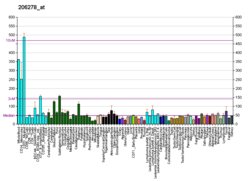
Summary
The platelet-activating factor receptor (PAF-R) is a G-protein coupled receptor which binds platelet-activating factor.[5][6] It is encoded in the human by the PTAFR gene.
| PTAFR | |||||||||||||||||||||||||||||||||||||||||||||||||||
|---|---|---|---|---|---|---|---|---|---|---|---|---|---|---|---|---|---|---|---|---|---|---|---|---|---|---|---|---|---|---|---|---|---|---|---|---|---|---|---|---|---|---|---|---|---|---|---|---|---|---|---|
| |||||||||||||||||||||||||||||||||||||||||||||||||||
| Identifiers | |||||||||||||||||||||||||||||||||||||||||||||||||||
| Aliases | PTAFR, PAFR, platelet activating factor receptor | ||||||||||||||||||||||||||||||||||||||||||||||||||
| External IDs | OMIM: 173393 MGI: 106066 HomoloGene: 20260 GeneCards: PTAFR | ||||||||||||||||||||||||||||||||||||||||||||||||||
| |||||||||||||||||||||||||||||||||||||||||||||||||||
| |||||||||||||||||||||||||||||||||||||||||||||||||||
| |||||||||||||||||||||||||||||||||||||||||||||||||||
| |||||||||||||||||||||||||||||||||||||||||||||||||||
| |||||||||||||||||||||||||||||||||||||||||||||||||||
| Wikidata | |||||||||||||||||||||||||||||||||||||||||||||||||||
| |||||||||||||||||||||||||||||||||||||||||||||||||||
The PAF receptor shows structural characteristics of the rhodopsin (MIM 180380) gene family and binds platelet-activating factor (PAF). PAF is a phospholipid (1-0-alkyl-2-acetyl-sn-glycero-3-phosphorylcholine) that has been implicated as a mediator in diverse pathologic processes, such as allergy, asthma, septic shock, arterial thrombosis, and inflammatory processes.[supplied by OMIM][7] Its pathogenetic role in chronic kidney failure has also been reported recently.[8]
Ligands edit
Agonists
Antagonists
- Apafant (WEB-2086)
- Israpafant (Y-24180)
- Lexipafant
- Rupatadine
References edit
- ^ a b c GRCh38: Ensembl release 89: ENSG00000169403 – Ensembl, May 2017
- ^ a b c GRCm38: Ensembl release 89: ENSMUSG00000056529 – Ensembl, May 2017
- ^ "Human PubMed Reference:". National Center for Biotechnology Information, U.S. National Library of Medicine.
- ^ "Mouse PubMed Reference:". National Center for Biotechnology Information, U.S. National Library of Medicine.
- ^ Seyfried CE, Schweickart VL, Godiska R, Gray PW (1992). "The human platelet-activating factor receptor gene (PTAFR) contains no introns and maps to chromosome 1". Genomics. 13 (3): 832–4. doi:10.1016/0888-7543(92)90162-L. PMID 1322356.
- ^ Ishii S, Nagase T, Shimizu T (2002). "Platelet-activating factor receptor". Prostaglandins Other Lipid Mediat. 68–69: 599–609. doi:10.1016/S0090-6980(02)00058-8. PMID 12432946.
- ^ "Entrez Gene: PTAFR platelet-activating factor receptor".
- ^ Correa-Costa M (Apr 2014). "Activation of platelet-activating factor receptor exacerbates renal inflammation and promotes fibrosis". Lab. Invest. 94 (4): 455–466. doi:10.1038/labinvest.2013.155. PMID 24492283.
Further reading edit
- Shukla SD (1992). "Platelet-activating factor receptor and signal transduction mechanisms". FASEB J. 6 (6): 2296–301. doi:10.1096/fasebj.6.6.1312046. PMID 1312046. S2CID 6000303.
- Sugimoto T, Tsuchimochi H, McGregor CG, et al. (1993). "Molecular cloning and characterization of the platelet-activating factor receptor gene expressed in the human heart". Biochem. Biophys. Res. Commun. 189 (2): 617–24. doi:10.1016/0006-291X(92)92245-S. PMID 1281995.
- Seyfried CE, Schweickart VL, Godiska R, Gray PW (1992). "The human platelet-activating factor receptor gene (PTAFR) contains no introns and maps to chromosome 1". Genomics. 13 (3): 832–4. doi:10.1016/0888-7543(92)90162-L. PMID 1322356.
- Kunz D, Gerard NP, Gerard C (1992). "The human leukocyte platelet-activating factor receptor. cDNA cloning, cell surface expression, and construction of a novel epitope-bearing analog". J. Biol. Chem. 267 (13): 9101–6. doi:10.1016/S0021-9258(19)50394-5. PMID 1374385.
- Ye RD, Prossnitz ER, Zou AH, Cochrane CG (1991). "Characterization of a human cDNA that encodes a functional receptor for platelet activating factor". Biochem. Biophys. Res. Commun. 180 (1): 105–11. doi:10.1016/S0006-291X(05)81261-6. PMID 1656963.
- Nakamura M, Honda Z, Izumi T, et al. (1991). "Molecular cloning and expression of platelet-activating factor receptor from human leukocytes". J. Biol. Chem. 266 (30): 20400–5. doi:10.1016/S0021-9258(18)54936-X. PMID 1657923.
- Haslam RJ, Williams KA, Davidson MM (1985). "Receptor-Effector Coupling in Platelets: Roles of Guanine Nucleotides". Mechanisms of Stimulus—Response Coupling in Platelets. Advances in Experimental Medicine and Biology. Vol. 192. pp. 265–80. doi:10.1007/978-1-4615-9442-0_19. ISBN 978-1-4615-9444-4. PMID 3010668.
- Valone FH (1984). "Isolation of a platelet membrane protein which binds the platelet-activating factor 1-0-hexadecyl-2-acetyl-SN-glycero-3-phosphorylcholine". Immunology. 52 (1): 169–74. PMC 1454573. PMID 6325330.
- Cundell DR, Gerard NP, Gerard C, et al. (1995). "Streptococcus pneumoniae anchor to activated human cells by the receptor for platelet-activating factor". Nature. 377 (6548): 435–8. Bibcode:1995Natur.377..435C. doi:10.1038/377435a0. PMID 7566121. S2CID 4318257.
- Izumi T, Kishimoto S, Takano T, et al. (1995). "Expression of human platelet-activating factor receptor gene in EoL-1 cells following butyrate-induced differentiation". Biochem. J. 305. ( Pt 3) (3): 829–35. doi:10.1042/bj3050829. PMC 1136334. PMID 7848283.
- Bito H, Honda Z, Nakamura M, Shimizu T (1994). "Cloning, expression and tissue distribution of rat platelet-activating-factor-receptor cDNA". Eur. J. Biochem. 221 (1): 211–8. doi:10.1111/j.1432-1033.1994.tb18731.x. PMID 8168510.
- Chase PB, Halonen M, Regan JW (1993). "Cloning of a human platelet-activating factor receptor gene: evidence for an intron in the 5'-untranslated region". Am. J. Respir. Cell Mol. Biol. 8 (3): 240–4. doi:10.1165/ajrcmb/8.3.240. PMID 8383507.
- Mutoh H, Bito H, Minami M, et al. (1993). "Two different promoters direct expression of two distinct forms of mRNAs of human platelet-activating factor receptor". FEBS Lett. 322 (2): 129–34. doi:10.1016/0014-5793(93)81552-B. PMID 8387031. S2CID 44640249.
- Nakamura M, Honda Z, Matsumoto T, et al. (1993). "Isolation and properties of platelet-activating factor receptor cDNAs". Journal of Lipid Mediators. 6 (1–3): 163–8. PMID 8395240.
- Kishimoto S, Shimadzu W, Izumi T, et al. (1996). "Regulation by IL-5 of expression of functional platelet-activating factor receptors on human eosinophils". J. Immunol. 157 (9): 4126–32. doi:10.4049/jimmunol.157.9.4126. PMID 8892648.
- Chase PB, Yang JM, Thompson FH, et al. (1997). "Regional mapping of the human platelet-activating factor receptor gene (PTAFR) to 1p35→p34.3 by fluorescence in situ hybridization". Cytogenet. Cell Genet. 72 (2–3): 205–7. doi:10.1159/000134190. PMID 8978777.
- Le Gouill C, Parent JL, Rola-Pleszczynski M, Stanková J (1997). "Role of the Cys90, Cys95 and Cys173 residues in the structure and function of the human platelet-activating factor receptor". FEBS Lett. 402 (2–3): 203–8. doi:10.1016/S0014-5793(96)01531-1. PMID 9037196. S2CID 21074692.
- Ahmed A, Dearn S, Shams M, et al. (1998). "Localization, quantification, and activation of platelet-activating factor receptor in human endometrium during the menstrual cycle: PAF stimulates NO, VEGF, and FAKpp125". FASEB J. 12 (10): 831–43. doi:10.1096/fasebj.12.10.831. PMID 9657523. S2CID 17474972.
- Cargill M, Altshuler D, Ireland J, et al. (1999). "Characterization of single-nucleotide polymorphisms in coding regions of human genes". Nat. Genet. 22 (3): 231–8. doi:10.1038/10290. PMID 10391209. S2CID 195213008.
External links edit
- "Platelet-Activating Factor Receptor". IUPHAR Database of Receptors and Ion Channels. International Union of Basic and Clinical Pharmacology. Archived from the original on 2016-03-03. Retrieved 2007-10-25.
- platelet+activating+factor+receptor at the U.S. National Library of Medicine Medical Subject Headings (MeSH)
This article incorporates text from the United States National Library of Medicine, which is in the public domain.








